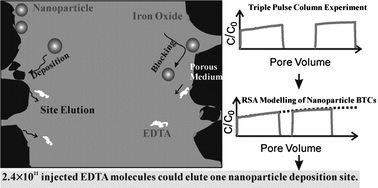Quantifying the influence of EDTA on polymernanoparticle deposition and retention in an iron-oxide-coated sand column†
Abstract
Ethylenediaminotetraacetic acid (EDTA) occurring in groundwater aquifers complicates the prediction of

* Corresponding authors
a
Key Laboratory of Soil Environment and Pollution Remediation, Institute of Soil Science, Chinese Academy of Sciences (CAS), Nanjing 210008, China
E-mail:
yangxinyao@hotmail.com
Fax: +86-028-82652669
Tel: +86-028-86291390
b School of Resources and Environment, Sichuan Agricultural University, Chengdu 611130, China
Ethylenediaminotetraacetic acid (EDTA) occurring in groundwater aquifers complicates the prediction of

 Please wait while we load your content...
Something went wrong. Try again?
Please wait while we load your content...
Something went wrong. Try again?
X. Yang, D. Liang and S. Deng, J. Environ. Monit., 2012, 14, 2392 DOI: 10.1039/C2EM30145H
To request permission to reproduce material from this article, please go to the Copyright Clearance Center request page.
If you are an author contributing to an RSC publication, you do not need to request permission provided correct acknowledgement is given.
If you are the author of this article, you do not need to request permission to reproduce figures and diagrams provided correct acknowledgement is given. If you want to reproduce the whole article in a third-party publication (excluding your thesis/dissertation for which permission is not required) please go to the Copyright Clearance Center request page.
Read more about how to correctly acknowledge RSC content.
 Fetching data from CrossRef.
Fetching data from CrossRef.
This may take some time to load.
Loading related content
